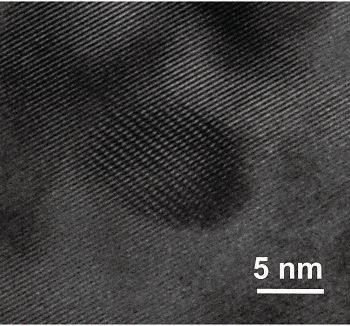High-power-factor thermoelectric material
Dr. Neil Canter, Contributing Editor | TLT Tech Beat July 2015
Researchers evaluate a new thermoelectric material based on magnesium, tin and germanium.
KEY CONCEPTS
•
Thermoelectric materials that exhibit excellent electrical conductivity and poor thermal conductivity at a temperature of about 300 C have been difficult to find.
•
A new thermoelectric material based on magnesium, tin and germanium with a minor amount of antimony has been prepared that exhibits a high peak figure of merit value and a high peak power factor.
•
This material contains nanoinclusions that play a role in limiting thermal conductivity.
HEAT GENERATED AS A BY-PRODUCT OF PROCESSES SUCH AS COMBUSTION in an automobile engine has been typically wasted. With the growing emphasis on efficiency, more attention is now being paid to utilize this energy.
Thermoelectric materials are well-suited to convert heat into electricity, which is a more useful energy form. They function by taking advantage of a difference in temperature in a specific application, such as the tailpipe of an automobile where the temperature of the exhaust gas from a diesel engine is between 300-400 C and ambient temperature to generate electricity. Excellent electrical conductivity along with poor thermal conductivity of the thermoelectric materials is required. The latter is important because the thermoelectric material cannot conduct heat well, otherwise it will be difficult to maintain the temperature difference in a specific application.
Finding efficient thermoelectric materials that can exhibit these features particularly at a temperature of about 300 C has been difficult. Zhifeng Ren, Anderson Chair professor of physics at the University of Houston in Houston, Texas, says, “Thermoelectric materials that have been evaluated include skutterudites and lead chalcogenides. Both types exhibit good thermoelectric figure of merit (ZT) values in the 300-500 C range and low thermal conductivities. But skutterudites exhibit low ZT values below 300 C and lead chalcogenides are toxic, exhibit poor mechanical properties and are thermally unstable above 400 C.”
In a previous TLT article, a more environmentally friendly thermoelectric material known as indium-doped tin telluride was developed by Ren and researchers in Professor Gang Chen’s group at MIT (
1). Testing done on indium-doped tin telluride showed a peak ZT of 1.1 at an indium concentration of 0.25 atom percent at 600 C.
Ren points out that there has been too much emphasis placed on developing thermoelectric materials with high peak ZT values. He says, “Figure of merit characterizes how efficiently a thermoelectric material converts heat into electricity. Two other parameters that need to be taken into consideration are the power factor and the leg length.”
Power factor is a measure of how much power can be generated by the thermoelectric material. There is a direct correlation between a higher power factor and the eventual output power generated by the thermoelectric material. Leg length is a measure of the height of the thermoelectric legs. Ren says, “Leg lengths are typically about 2 mm. Reducing the distance more may seem to be a way to improve the output power, but thermal stress can act as a negative factor due to the large temperature gradient.”
In Ren’s view, thermoelectric materials are needed that combine both high ZT values and power factors. Such a material has now been developed.
MAGNESIUM TIN GERMANIUM SPECIES
Ren—in combination with colleagues at the University of Houston, Boston College and the Lawrence Berkeley National Laboratory—has developed and evaluated a new thermoelectric material based on magnesium, tin and germanium. He says, “In looking for better-performing materials, we knew that researchers had prepared an alloy of magnesium silicon with magnesium tin that shows a peak ZT value of approximately 1 at 500 C. Adjusting the stoichiometry of the mixture increased the ZT value to between 1.1 and 1.3. We decided to develop a magnesium tin compound with germanium because the latter provided to be an ideal element in providing good electrical conductivity and low thermal conductivity.”
The n-type thermoelectric material has the following composition: Mg
2Sn
0.75Ge
0.25 doped by a minor amount of antimony to tune the carrier concentration. It is prepared through ball milling for up to 20 hours followed by hot pressing into bulk samples through a direct current-induced process at a temperature between 600-750 C for two minutes.
This magnesium tin germanium species exhibits a peak power factor of 55 uW cm
-1 K
-2 and a peak ZT value of 1.4. Ren says, “We believe the power factor represents a significant increase as compared to other thermoelectric materials and in combination with the good ZT value means this species has promise as a material that can generate a high level of electricity from heat.”
One interesting aspect of the magnesium tin germanium species is the presence of nanoinclusions as shown in a photographic microstructure image seen in Figure 2. Ren says, “The nanoinclusions play a role in limiting the thermal conductivity in the thermoelectric material.”
 Figure 2. Nanoinclusions, such as the one shown in this image, limit the thermal conductivity and as a result help to boost the performance of a new thermoelectric material based on magnesium, tin, germanium and antimony. (Figure courtesy of the University of Houston.)
Figure 2. Nanoinclusions, such as the one shown in this image, limit the thermal conductivity and as a result help to boost the performance of a new thermoelectric material based on magnesium, tin, germanium and antimony. (Figure courtesy of the University of Houston.)
Ren will be continuing to evaluate new thermoelectric materials that display both high power factors and high ZT values. He says, “The currently prepared magnesium tin germanium species meets our initial goal of a material with a peak power factor above 40 and a ZT value greater than one. We are looking to find materials that exhibit the highest possible power factors and ZT values. Currently, we are evaluating new materials with maximum power factors above 55 and even above 100. The latter material has promise, but unfortunately has a low ZT value and high thermal conductivity.”
Further information on the magnesium tin germanium species can be found in a recent article (
2) or by contacting Ren at
zren@uh.edu.
REFERENCES
1.
Canter, N. (2013), “Environmentally friendly thermoelectric material,” TLT,
69 (11), pp. 13-14.
2.
Liu, W., Kim, H., Chen. S., Jie. Q., Lv, B., Yao, M., Ren, Z., Opeil, C., Wilson, S., Chu, C. and Rhen, Z. (2015), “N-type thermoelectric material Mg
2Sn
0.75Ge
0.25 for high power generation,”
Proceedings of the National Academy of Sciences,
112 (11), pp. 3269-3274.
 Neil Canter heads his own consulting company, Chemical Solutions, in Willow Grove, Pa. Ideas for Tech Beat can be submitted to him at neilcanter@comcast.net
Neil Canter heads his own consulting company, Chemical Solutions, in Willow Grove, Pa. Ideas for Tech Beat can be submitted to him at neilcanter@comcast.net.